Implementing BIM to Ellison Building from FM Perspective
VerifiedAdded on 2023/03/20
|22
|4125
|76
AI Summary
This reflective report discusses the implementation of BIM in Ellison Building (B Block) from the Facilities Management perspective. It explores the challenges faced, the methodology adopted, and the outcomes of using BIM in Facility Management. The report also provides recommendations and limitations for the implementation of BIM.
Contribute Materials
Your contribution can guide someone’s learning journey. Share your
documents today.
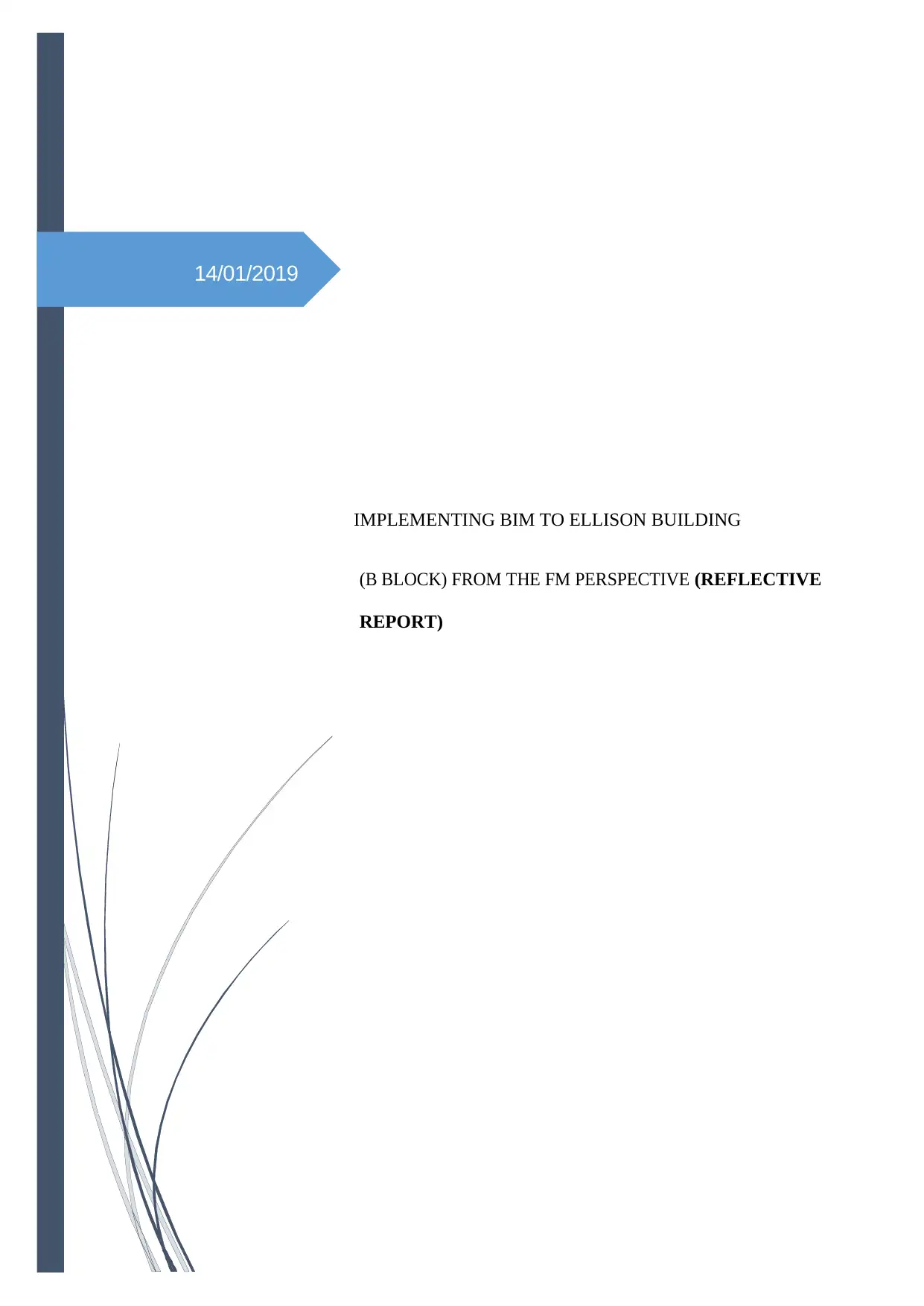
14/01/2019
IMPLEMENTING BIM TO ELLISON BUILDING
(B BLOCK) FROM THE FM PERSPECTIVE (REFLECTIVE
REPORT)
IMPLEMENTING BIM TO ELLISON BUILDING
(B BLOCK) FROM THE FM PERSPECTIVE (REFLECTIVE
REPORT)
Secure Best Marks with AI Grader
Need help grading? Try our AI Grader for instant feedback on your assignments.

K a R T HI CK Ka ND HaS a My
NORT HUMB RI a UN I VE RS IT y a T
N E W Ca ST L E
NORT HUMB RI a UN I VE RS IT y a T
N E W Ca ST L E
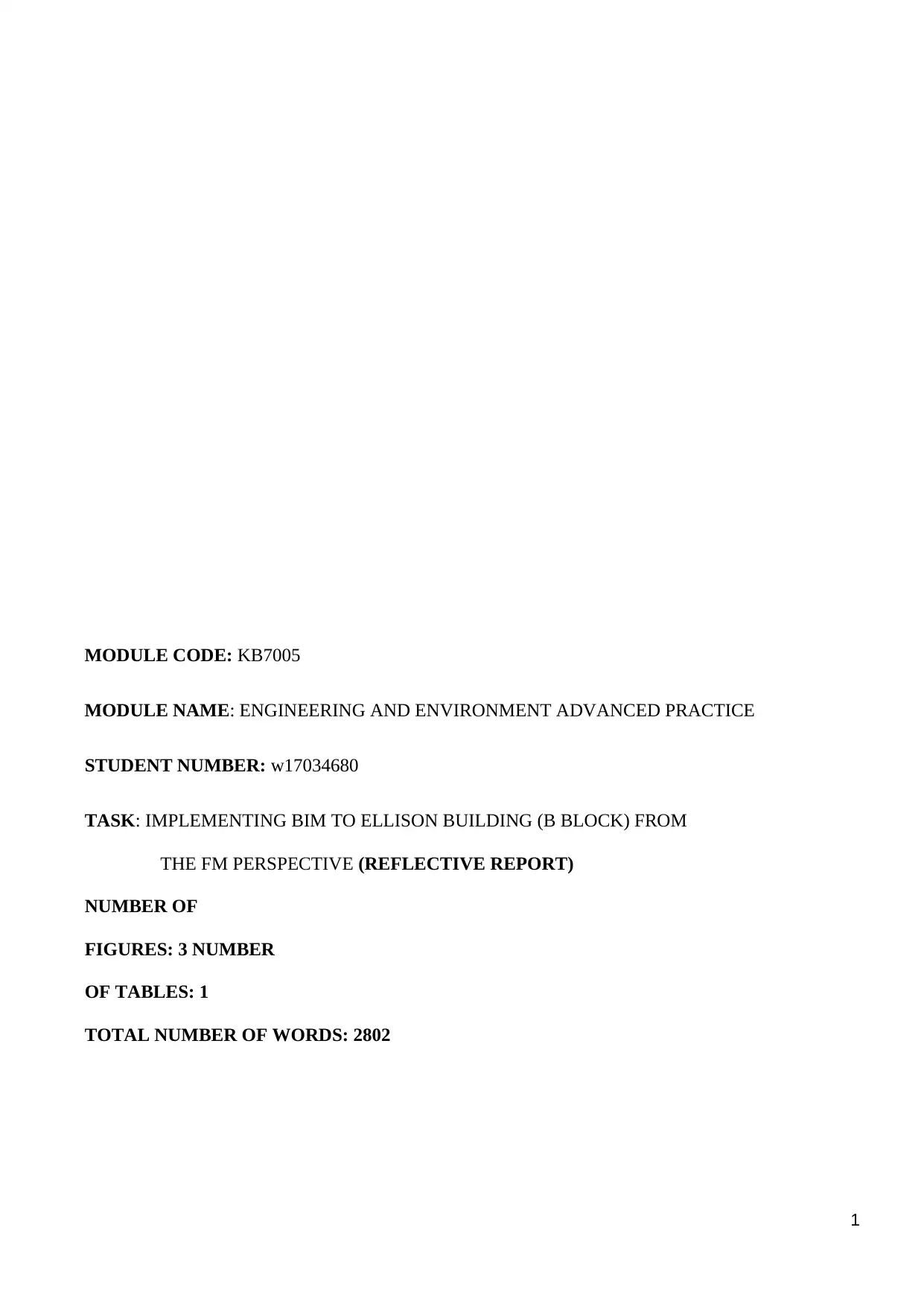
1
MODULE CODE: KB7005
MODULE NAME: ENGINEERING AND ENVIRONMENT ADVANCED PRACTICE
STUDENT NUMBER: w17034680
TASK: IMPLEMENTING BIM TO ELLISON BUILDING (B BLOCK) FROM
THE FM PERSPECTIVE (REFLECTIVE REPORT)
NUMBER OF
FIGURES: 3 NUMBER
OF TABLES: 1
TOTAL NUMBER OF WORDS: 2802
MODULE CODE: KB7005
MODULE NAME: ENGINEERING AND ENVIRONMENT ADVANCED PRACTICE
STUDENT NUMBER: w17034680
TASK: IMPLEMENTING BIM TO ELLISON BUILDING (B BLOCK) FROM
THE FM PERSPECTIVE (REFLECTIVE REPORT)
NUMBER OF
FIGURES: 3 NUMBER
OF TABLES: 1
TOTAL NUMBER OF WORDS: 2802
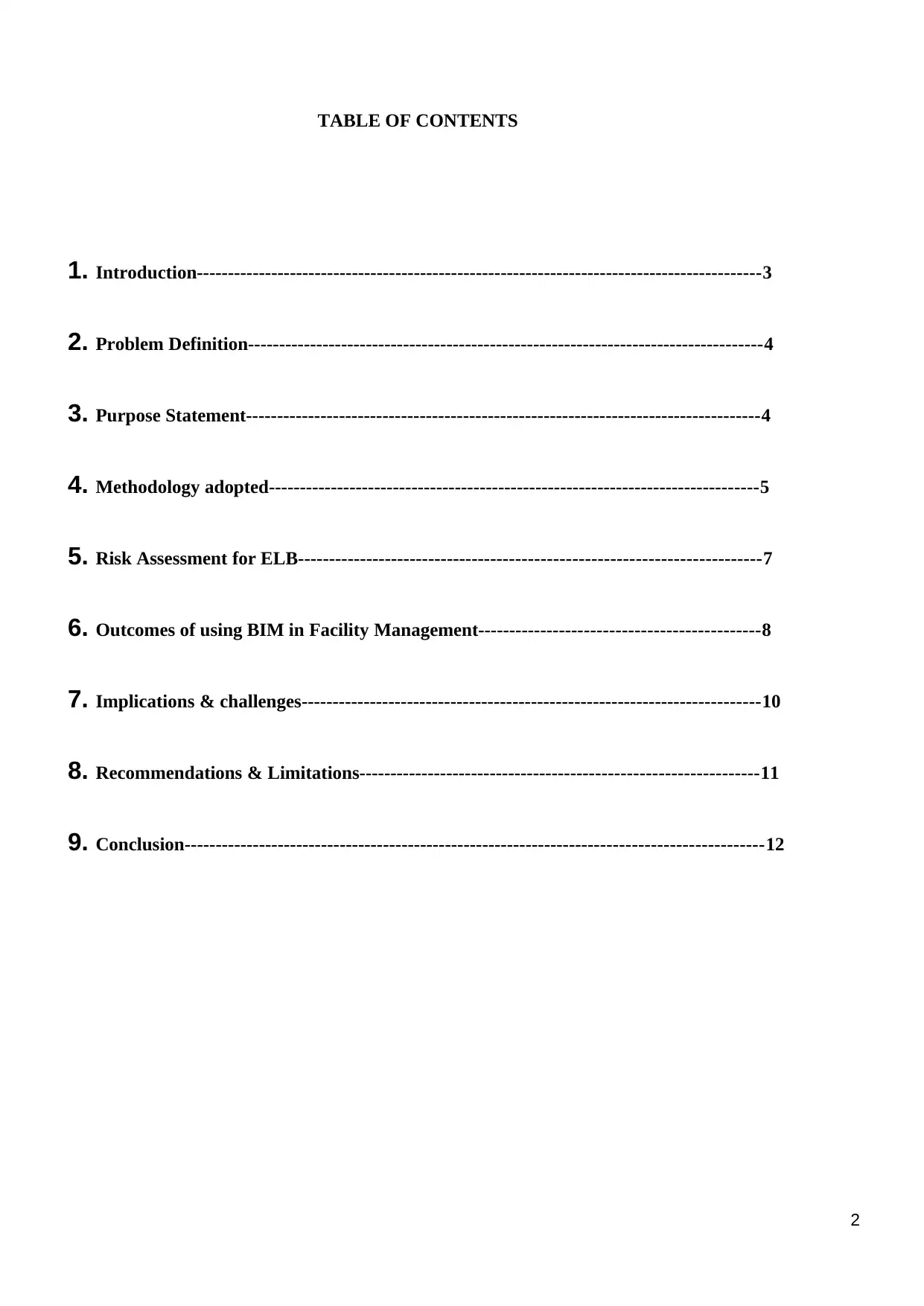
2
TABLE OF CONTENTS
1. Introduction-------------------------------------------------------------------------------------------3
2. Problem Definition-----------------------------------------------------------------------------------4
3. Purpose Statement-----------------------------------------------------------------------------------4
4. Methodology adopted-------------------------------------------------------------------------------5
5. Risk Assessment for ELB--------------------------------------------------------------------------7
6. Outcomes of using BIM in Facility Management---------------------------------------------8
7. Implications & challenges--------------------------------------------------------------------------10
8. Recommendations & Limitations----------------------------------------------------------------11
9. Conclusion---------------------------------------------------------------------------------------------12
TABLE OF CONTENTS
1. Introduction-------------------------------------------------------------------------------------------3
2. Problem Definition-----------------------------------------------------------------------------------4
3. Purpose Statement-----------------------------------------------------------------------------------4
4. Methodology adopted-------------------------------------------------------------------------------5
5. Risk Assessment for ELB--------------------------------------------------------------------------7
6. Outcomes of using BIM in Facility Management---------------------------------------------8
7. Implications & challenges--------------------------------------------------------------------------10
8. Recommendations & Limitations----------------------------------------------------------------11
9. Conclusion---------------------------------------------------------------------------------------------12
Secure Best Marks with AI Grader
Need help grading? Try our AI Grader for instant feedback on your assignments.
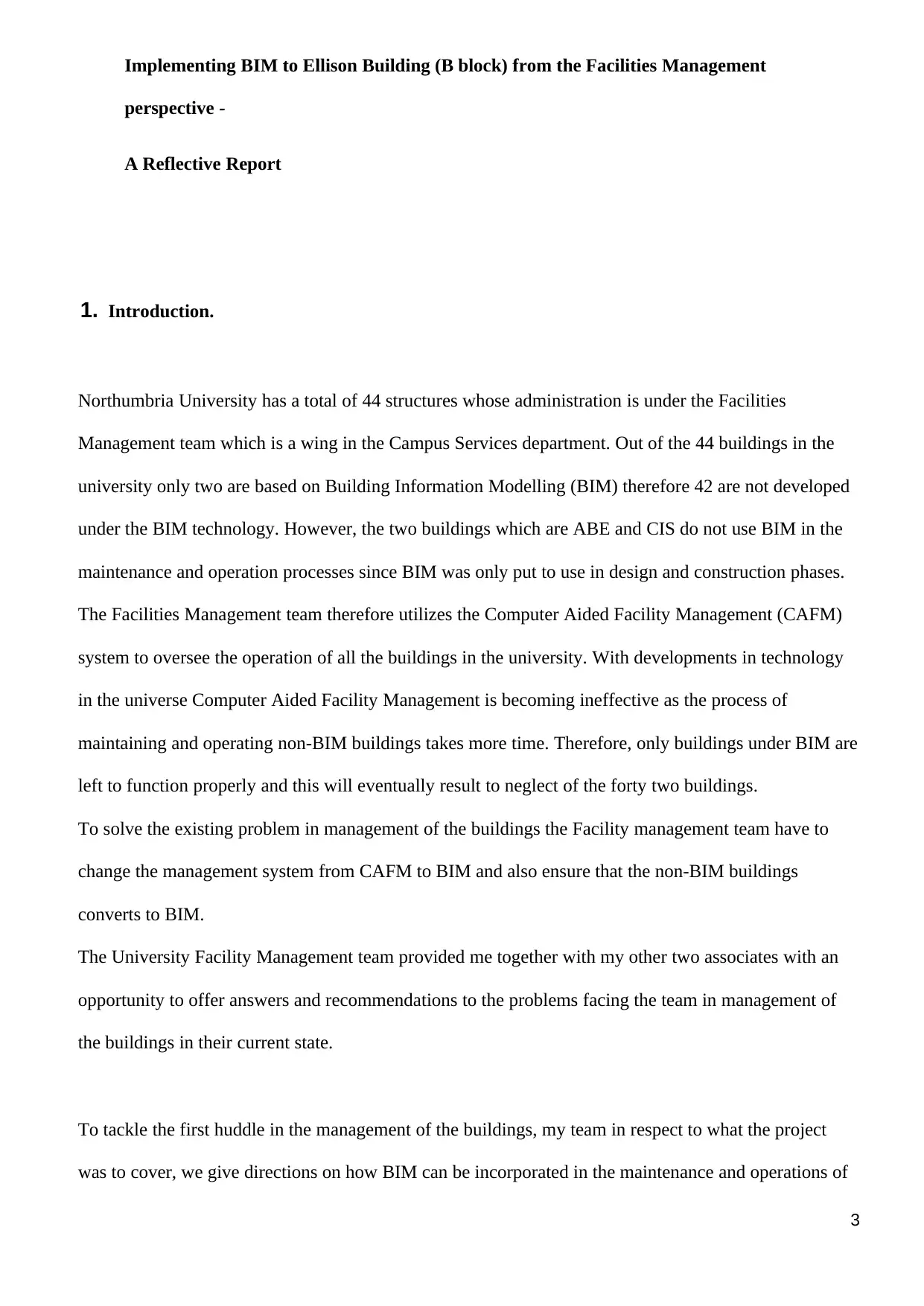
3
Implementing BIM to Ellison Building (B block) from the Facilities Management
perspective -
A Reflective Report
1. Introduction.
Northumbria University has a total of 44 structures whose administration is under the Facilities
Management team which is a wing in the Campus Services department. Out of the 44 buildings in the
university only two are based on Building Information Modelling (BIM) therefore 42 are not developed
under the BIM technology. However, the two buildings which are ABE and CIS do not use BIM in the
maintenance and operation processes since BIM was only put to use in design and construction phases.
The Facilities Management team therefore utilizes the Computer Aided Facility Management (CAFM)
system to oversee the operation of all the buildings in the university. With developments in technology
in the universe Computer Aided Facility Management is becoming ineffective as the process of
maintaining and operating non-BIM buildings takes more time. Therefore, only buildings under BIM are
left to function properly and this will eventually result to neglect of the forty two buildings.
To solve the existing problem in management of the buildings the Facility management team have to
change the management system from CAFM to BIM and also ensure that the non-BIM buildings
converts to BIM.
The University Facility Management team provided me together with my other two associates with an
opportunity to offer answers and recommendations to the problems facing the team in management of
the buildings in their current state.
To tackle the first huddle in the management of the buildings, my team in respect to what the project
was to cover, we give directions on how BIM can be incorporated in the maintenance and operations of
Implementing BIM to Ellison Building (B block) from the Facilities Management
perspective -
A Reflective Report
1. Introduction.
Northumbria University has a total of 44 structures whose administration is under the Facilities
Management team which is a wing in the Campus Services department. Out of the 44 buildings in the
university only two are based on Building Information Modelling (BIM) therefore 42 are not developed
under the BIM technology. However, the two buildings which are ABE and CIS do not use BIM in the
maintenance and operation processes since BIM was only put to use in design and construction phases.
The Facilities Management team therefore utilizes the Computer Aided Facility Management (CAFM)
system to oversee the operation of all the buildings in the university. With developments in technology
in the universe Computer Aided Facility Management is becoming ineffective as the process of
maintaining and operating non-BIM buildings takes more time. Therefore, only buildings under BIM are
left to function properly and this will eventually result to neglect of the forty two buildings.
To solve the existing problem in management of the buildings the Facility management team have to
change the management system from CAFM to BIM and also ensure that the non-BIM buildings
converts to BIM.
The University Facility Management team provided me together with my other two associates with an
opportunity to offer answers and recommendations to the problems facing the team in management of
the buildings in their current state.
To tackle the first huddle in the management of the buildings, my team in respect to what the project
was to cover, we give directions on how BIM can be incorporated in the maintenance and operations of
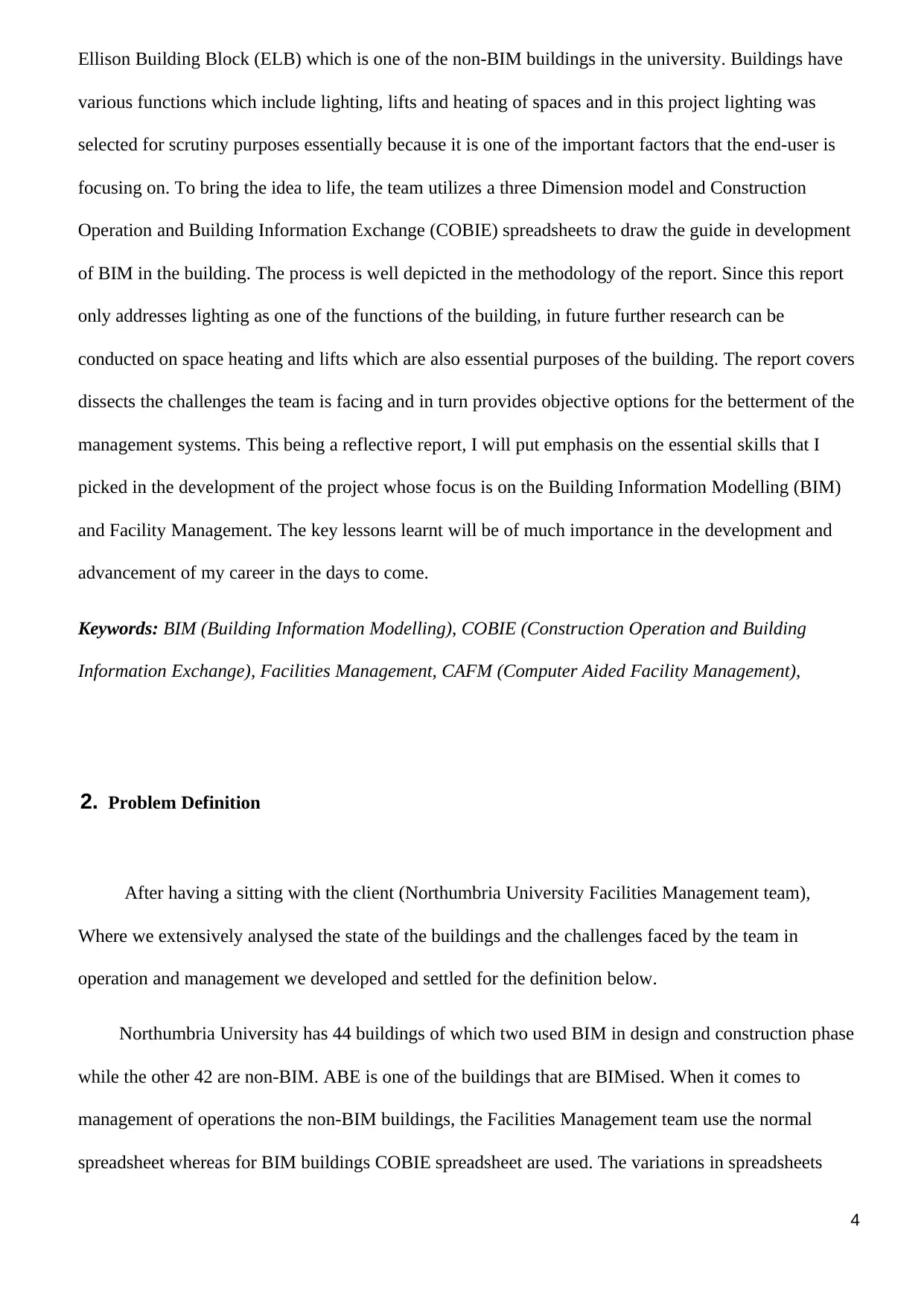
4
Ellison Building Block (ELB) which is one of the non-BIM buildings in the university. Buildings have
various functions which include lighting, lifts and heating of spaces and in this project lighting was
selected for scrutiny purposes essentially because it is one of the important factors that the end-user is
focusing on. To bring the idea to life, the team utilizes a three Dimension model and Construction
Operation and Building Information Exchange (COBIE) spreadsheets to draw the guide in development
of BIM in the building. The process is well depicted in the methodology of the report. Since this report
only addresses lighting as one of the functions of the building, in future further research can be
conducted on space heating and lifts which are also essential purposes of the building. The report covers
dissects the challenges the team is facing and in turn provides objective options for the betterment of the
management systems. This being a reflective report, I will put emphasis on the essential skills that I
picked in the development of the project whose focus is on the Building Information Modelling (BIM)
and Facility Management. The key lessons learnt will be of much importance in the development and
advancement of my career in the days to come.
Keywords: BIM (Building Information Modelling), COBIE (Construction Operation and Building
Information Exchange), Facilities Management, CAFM (Computer Aided Facility Management),
2. Problem Definition
After having a sitting with the client (Northumbria University Facilities Management team),
Where we extensively analysed the state of the buildings and the challenges faced by the team in
operation and management we developed and settled for the definition below.
Northumbria University has 44 buildings of which two used BIM in design and construction phase
while the other 42 are non-BIM. ABE is one of the buildings that are BIMised. When it comes to
management of operations the non-BIM buildings, the Facilities Management team use the normal
spreadsheet whereas for BIM buildings COBIE spreadsheet are used. The variations in spreadsheets
Ellison Building Block (ELB) which is one of the non-BIM buildings in the university. Buildings have
various functions which include lighting, lifts and heating of spaces and in this project lighting was
selected for scrutiny purposes essentially because it is one of the important factors that the end-user is
focusing on. To bring the idea to life, the team utilizes a three Dimension model and Construction
Operation and Building Information Exchange (COBIE) spreadsheets to draw the guide in development
of BIM in the building. The process is well depicted in the methodology of the report. Since this report
only addresses lighting as one of the functions of the building, in future further research can be
conducted on space heating and lifts which are also essential purposes of the building. The report covers
dissects the challenges the team is facing and in turn provides objective options for the betterment of the
management systems. This being a reflective report, I will put emphasis on the essential skills that I
picked in the development of the project whose focus is on the Building Information Modelling (BIM)
and Facility Management. The key lessons learnt will be of much importance in the development and
advancement of my career in the days to come.
Keywords: BIM (Building Information Modelling), COBIE (Construction Operation and Building
Information Exchange), Facilities Management, CAFM (Computer Aided Facility Management),
2. Problem Definition
After having a sitting with the client (Northumbria University Facilities Management team),
Where we extensively analysed the state of the buildings and the challenges faced by the team in
operation and management we developed and settled for the definition below.
Northumbria University has 44 buildings of which two used BIM in design and construction phase
while the other 42 are non-BIM. ABE is one of the buildings that are BIMised. When it comes to
management of operations the non-BIM buildings, the Facilities Management team use the normal
spreadsheet whereas for BIM buildings COBIE spreadsheet are used. The variations in spreadsheets
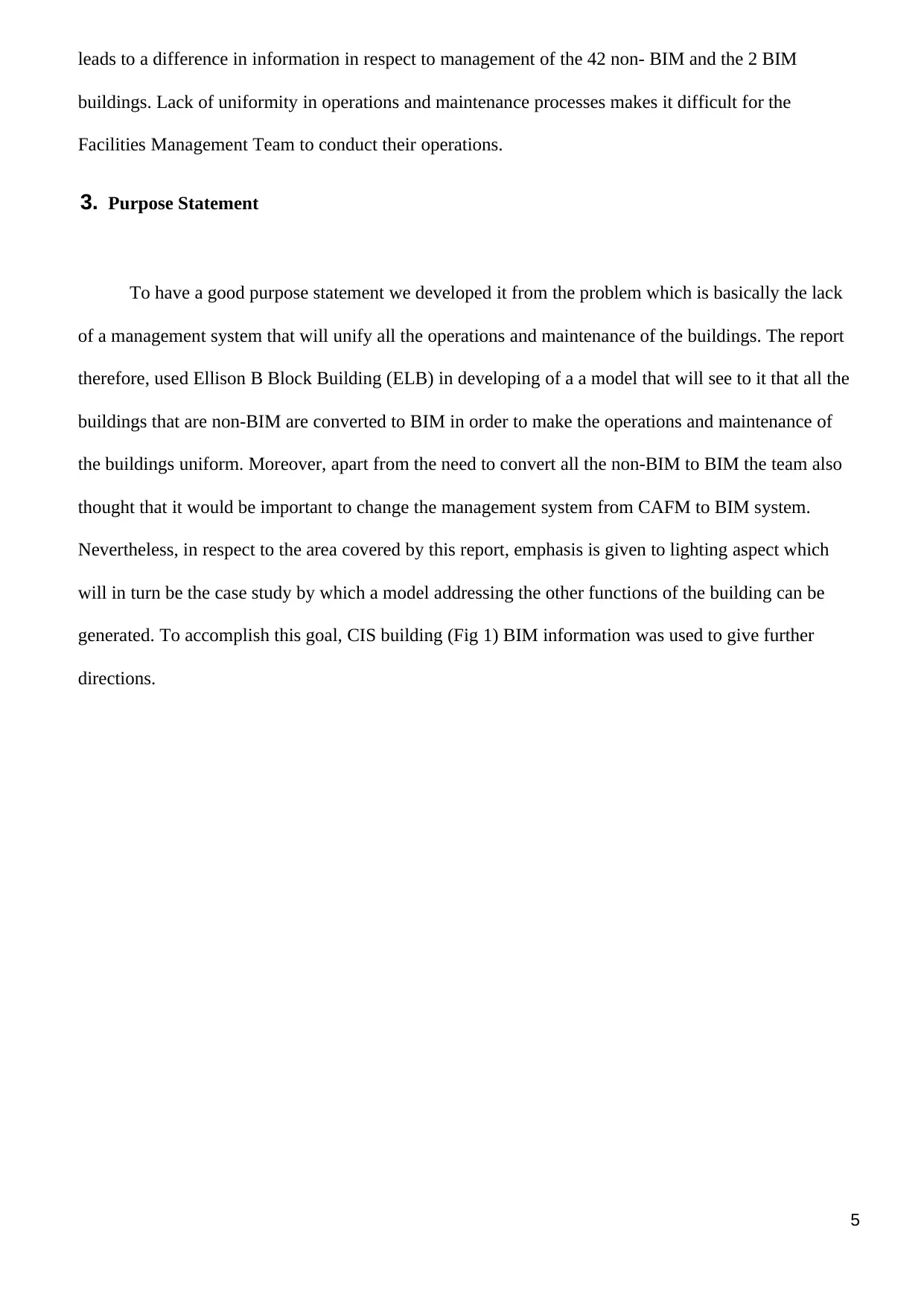
5
leads to a difference in information in respect to management of the 42 non- BIM and the 2 BIM
buildings. Lack of uniformity in operations and maintenance processes makes it difficult for the
Facilities Management Team to conduct their operations.
3. Purpose Statement
To have a good purpose statement we developed it from the problem which is basically the lack
of a management system that will unify all the operations and maintenance of the buildings. The report
therefore, used Ellison B Block Building (ELB) in developing of a a model that will see to it that all the
buildings that are non-BIM are converted to BIM in order to make the operations and maintenance of
the buildings uniform. Moreover, apart from the need to convert all the non-BIM to BIM the team also
thought that it would be important to change the management system from CAFM to BIM system.
Nevertheless, in respect to the area covered by this report, emphasis is given to lighting aspect which
will in turn be the case study by which a model addressing the other functions of the building can be
generated. To accomplish this goal, CIS building (Fig 1) BIM information was used to give further
directions.
leads to a difference in information in respect to management of the 42 non- BIM and the 2 BIM
buildings. Lack of uniformity in operations and maintenance processes makes it difficult for the
Facilities Management Team to conduct their operations.
3. Purpose Statement
To have a good purpose statement we developed it from the problem which is basically the lack
of a management system that will unify all the operations and maintenance of the buildings. The report
therefore, used Ellison B Block Building (ELB) in developing of a a model that will see to it that all the
buildings that are non-BIM are converted to BIM in order to make the operations and maintenance of
the buildings uniform. Moreover, apart from the need to convert all the non-BIM to BIM the team also
thought that it would be important to change the management system from CAFM to BIM system.
Nevertheless, in respect to the area covered by this report, emphasis is given to lighting aspect which
will in turn be the case study by which a model addressing the other functions of the building can be
generated. To accomplish this goal, CIS building (Fig 1) BIM information was used to give further
directions.
Paraphrase This Document
Need a fresh take? Get an instant paraphrase of this document with our AI Paraphraser

6
Fig 1: Map showing the CIS block and Ellison B block
4. Methodology adopted
Analysing the CIS building documents
We were provided with BIM documents of the CIS building for use to delve into and come up with a
replica of the same meant of the Ellison B block in respect to specific building functions as according to
the Facilities Management system. To start with, we connected the lighting function of the building to
the BIM system as a case study which would also facilitate the BIMisation of space heating and lifts
functions. Since CIS building was using COBIE spreadsheet and 3D model in Facility Management we
therefore had to delved into the BIM information provided to facilitate the alteration of 3D in ELB to the
3D and COBIE spreadsheet present in CIS building.
Fig 1: Map showing the CIS block and Ellison B block
4. Methodology adopted
Analysing the CIS building documents
We were provided with BIM documents of the CIS building for use to delve into and come up with a
replica of the same meant of the Ellison B block in respect to specific building functions as according to
the Facilities Management system. To start with, we connected the lighting function of the building to
the BIM system as a case study which would also facilitate the BIMisation of space heating and lifts
functions. Since CIS building was using COBIE spreadsheet and 3D model in Facility Management we
therefore had to delved into the BIM information provided to facilitate the alteration of 3D in ELB to the
3D and COBIE spreadsheet present in CIS building.

7
Fig 2: 2D Floor plan of ELB
Information’s required for generating COBIE for FM
Patacas et al., (2015) list the information needed for developing the assets register using COBIE spreadsheet
are as follows (Tab 1).
S.NO Assets register requirements COBIE data drop
1. Identification number for the assets 4 – as built stage
2. Make/ model 4 – as built stage
3. Manufacturer 4 – as built stage
4. Date of manufacturer 4 – as built stage
5. Date of installation or completion
date of construction
4 – as built stage
6. Location of the function 4 – as built stage
7. Access equipment required 5 – O & M
8. Do the assets requires a permit – to 5 – O & M
Fig 2: 2D Floor plan of ELB
Information’s required for generating COBIE for FM
Patacas et al., (2015) list the information needed for developing the assets register using COBIE spreadsheet
are as follows (Tab 1).
S.NO Assets register requirements COBIE data drop
1. Identification number for the assets 4 – as built stage
2. Make/ model 4 – as built stage
3. Manufacturer 4 – as built stage
4. Date of manufacturer 4 – as built stage
5. Date of installation or completion
date of construction
4 – as built stage
6. Location of the function 4 – as built stage
7. Access equipment required 5 – O & M
8. Do the assets requires a permit – to 5 – O & M
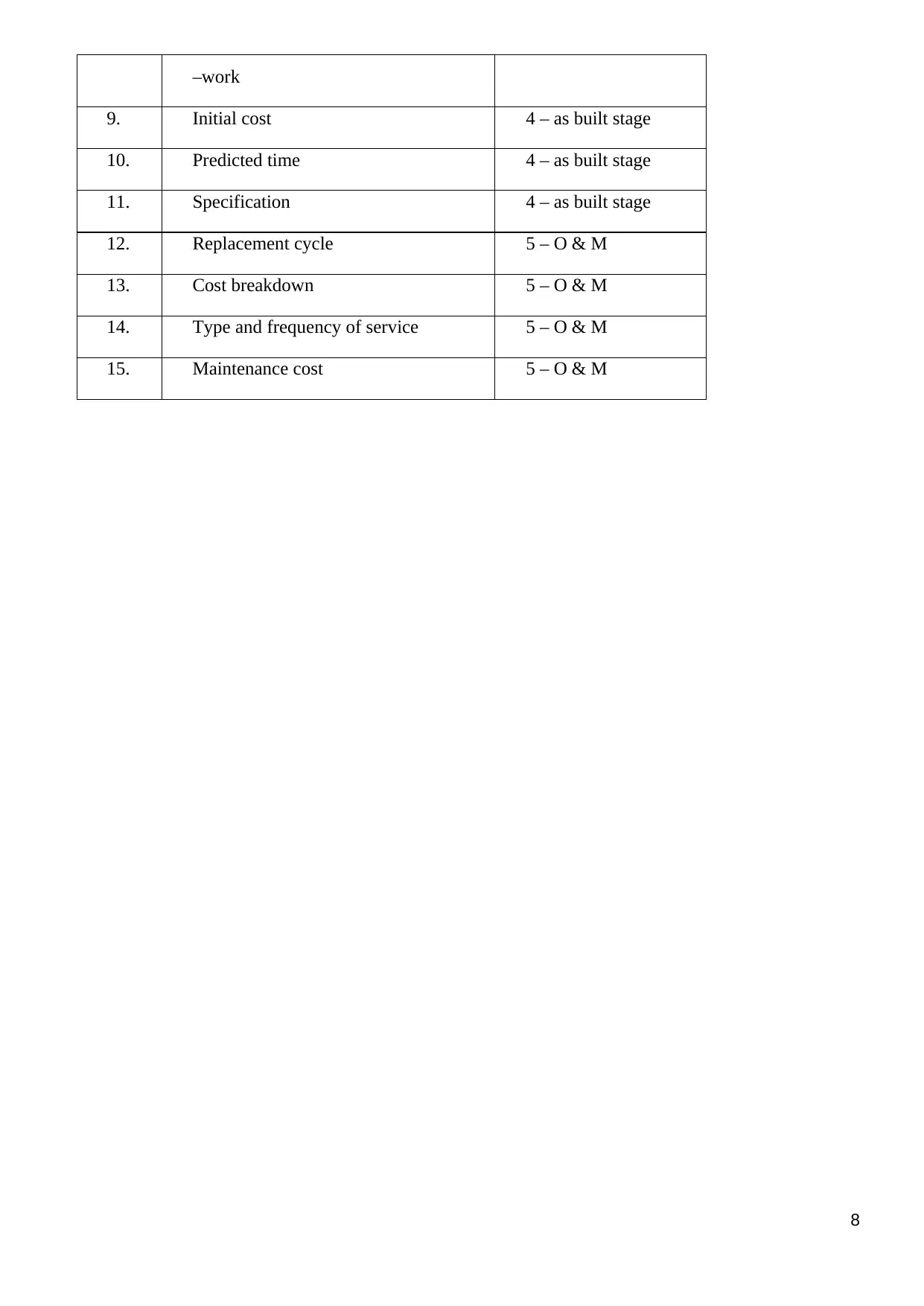
8
–work
9. Initial cost 4 – as built stage
10. Predicted time 4 – as built stage
11. Specification 4 – as built stage
12. Replacement cycle 5 – O & M
13. Cost breakdown 5 – O & M
14. Type and frequency of service 5 – O & M
15. Maintenance cost 5 – O & M
–work
9. Initial cost 4 – as built stage
10. Predicted time 4 – as built stage
11. Specification 4 – as built stage
12. Replacement cycle 5 – O & M
13. Cost breakdown 5 – O & M
14. Type and frequency of service 5 – O & M
15. Maintenance cost 5 – O & M
Secure Best Marks with AI Grader
Need help grading? Try our AI Grader for instant feedback on your assignments.

9
16. Source of components and spare
Parts
5 – O & M
17. Energy consumption 4 – as built stage
18. Hazardous and risks caused by the
Assets
4 – as built stage
Tab 1: Information required for generating COBIE spreadsheet using BIM
Interoperability issues
In the early stages of this report, we had to interact with different formats of drawings. The challenge
came a bout due to the fact that not all files could be viewed and edited in the same format. Therefore,
this made it difficult for us to work in unison.
ELB (Ellison Building B block)
“.dwg” format (AutoCAD 2018 version) for all floors
This file format only supports AutoCAD 2018 or the later version. It could not be opened in an
earlier version which is 2017 or lower.
CIS (Computer and Information Science Building)
Employer Information Requirement (EIR)
“.nwc” format (native Navisworks)
“. rvt” format (Revit 2016 version)
Industrial Foundation Class (IFC)
16. Source of components and spare
Parts
5 – O & M
17. Energy consumption 4 – as built stage
18. Hazardous and risks caused by the
Assets
4 – as built stage
Tab 1: Information required for generating COBIE spreadsheet using BIM
Interoperability issues
In the early stages of this report, we had to interact with different formats of drawings. The challenge
came a bout due to the fact that not all files could be viewed and edited in the same format. Therefore,
this made it difficult for us to work in unison.
ELB (Ellison Building B block)
“.dwg” format (AutoCAD 2018 version) for all floors
This file format only supports AutoCAD 2018 or the later version. It could not be opened in an
earlier version which is 2017 or lower.
CIS (Computer and Information Science Building)
Employer Information Requirement (EIR)
“.nwc” format (native Navisworks)
“. rvt” format (Revit 2016 version)
Industrial Foundation Class (IFC)
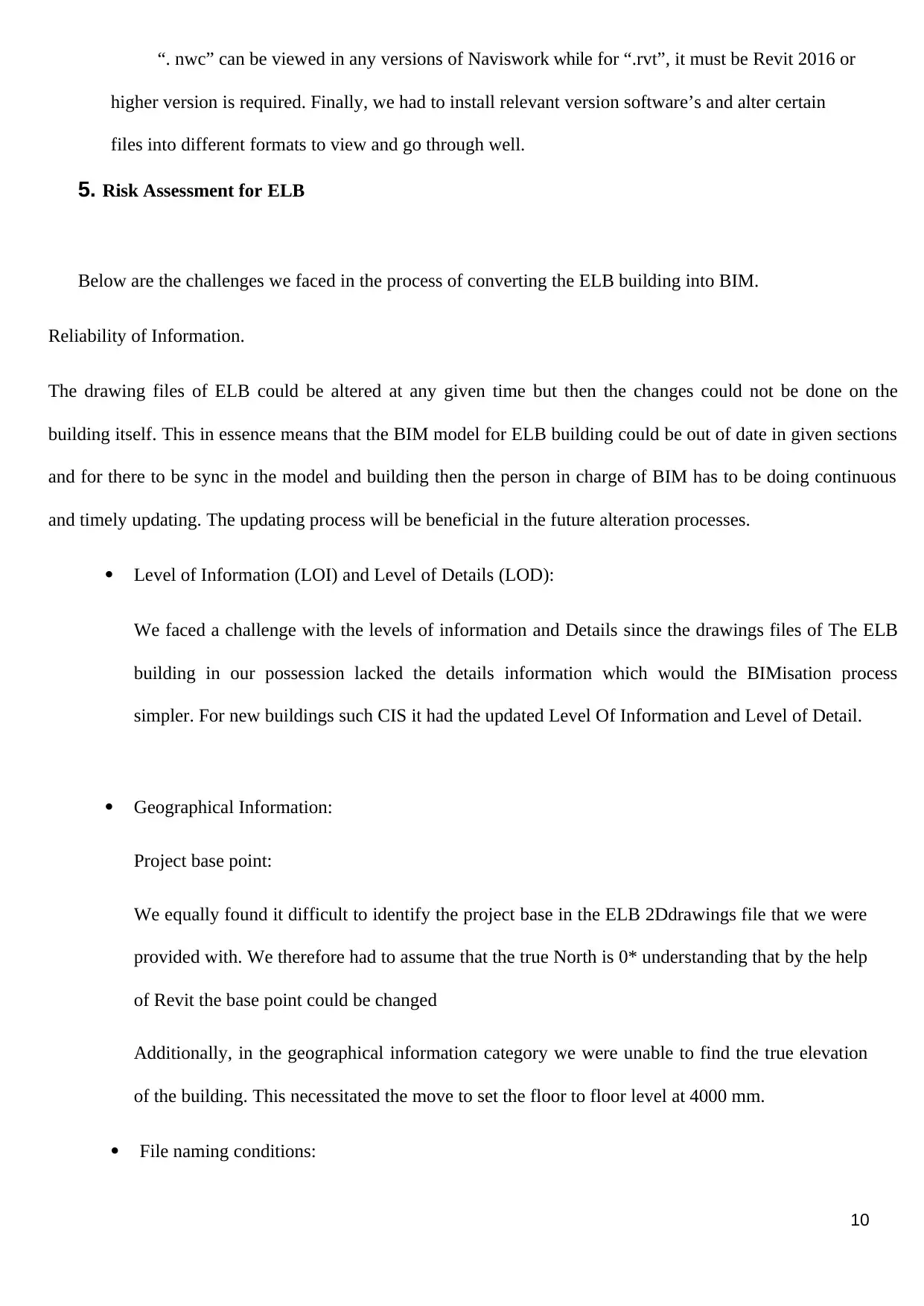
10
“. nwc” can be viewed in any versions of Naviswork while for “.rvt”, it must be Revit 2016 or
higher version is required. Finally, we had to install relevant version software’s and alter certain
files into different formats to view and go through well.
5. Risk Assessment for ELB
Below are the challenges we faced in the process of converting the ELB building into BIM.
Reliability of Information.
The drawing files of ELB could be altered at any given time but then the changes could not be done on the
building itself. This in essence means that the BIM model for ELB building could be out of date in given sections
and for there to be sync in the model and building then the person in charge of BIM has to be doing continuous
and timely updating. The updating process will be beneficial in the future alteration processes.
Level of Information (LOI) and Level of Details (LOD):
We faced a challenge with the levels of information and Details since the drawings files of The ELB
building in our possession lacked the details information which would the BIMisation process
simpler. For new buildings such CIS it had the updated Level Of Information and Level of Detail.
Geographical Information:
Project base point:
We equally found it difficult to identify the project base in the ELB 2Ddrawings file that we were
provided with. We therefore had to assume that the true North is 0* understanding that by the help
of Revit the base point could be changed
Additionally, in the geographical information category we were unable to find the true elevation
of the building. This necessitated the move to set the floor to floor level at 4000 mm.
File naming conditions:
“. nwc” can be viewed in any versions of Naviswork while for “.rvt”, it must be Revit 2016 or
higher version is required. Finally, we had to install relevant version software’s and alter certain
files into different formats to view and go through well.
5. Risk Assessment for ELB
Below are the challenges we faced in the process of converting the ELB building into BIM.
Reliability of Information.
The drawing files of ELB could be altered at any given time but then the changes could not be done on the
building itself. This in essence means that the BIM model for ELB building could be out of date in given sections
and for there to be sync in the model and building then the person in charge of BIM has to be doing continuous
and timely updating. The updating process will be beneficial in the future alteration processes.
Level of Information (LOI) and Level of Details (LOD):
We faced a challenge with the levels of information and Details since the drawings files of The ELB
building in our possession lacked the details information which would the BIMisation process
simpler. For new buildings such CIS it had the updated Level Of Information and Level of Detail.
Geographical Information:
Project base point:
We equally found it difficult to identify the project base in the ELB 2Ddrawings file that we were
provided with. We therefore had to assume that the true North is 0* understanding that by the help
of Revit the base point could be changed
Additionally, in the geographical information category we were unable to find the true elevation
of the building. This necessitated the move to set the floor to floor level at 4000 mm.
File naming conditions:
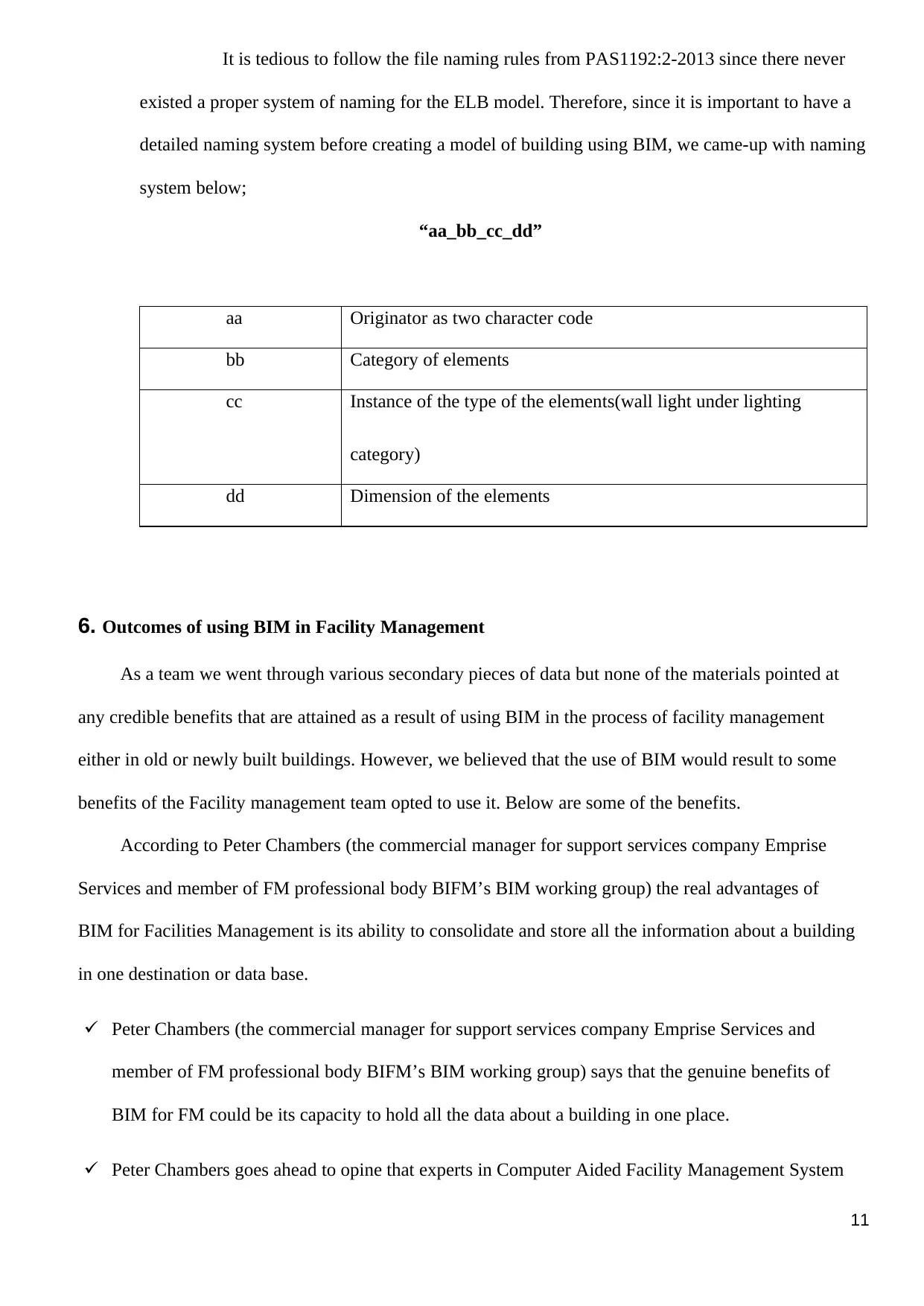
11
It is tedious to follow the file naming rules from PAS1192:2-2013 since there never
existed a proper system of naming for the ELB model. Therefore, since it is important to have a
detailed naming system before creating a model of building using BIM, we came-up with naming
system below;
“aa_bb_cc_dd”
aa Originator as two character code
bb Category of elements
cc Instance of the type of the elements(wall light under lighting
category)
dd Dimension of the elements
6. Outcomes of using BIM in Facility Management
As a team we went through various secondary pieces of data but none of the materials pointed at
any credible benefits that are attained as a result of using BIM in the process of facility management
either in old or newly built buildings. However, we believed that the use of BIM would result to some
benefits of the Facility management team opted to use it. Below are some of the benefits.
According to Peter Chambers (the commercial manager for support services company Emprise
Services and member of FM professional body BIFM’s BIM working group) the real advantages of
BIM for Facilities Management is its ability to consolidate and store all the information about a building
in one destination or data base.
Peter Chambers (the commercial manager for support services company Emprise Services and
member of FM professional body BIFM’s BIM working group) says that the genuine benefits of
BIM for FM could be its capacity to hold all the data about a building in one place.
Peter Chambers goes ahead to opine that experts in Computer Aided Facility Management System
It is tedious to follow the file naming rules from PAS1192:2-2013 since there never
existed a proper system of naming for the ELB model. Therefore, since it is important to have a
detailed naming system before creating a model of building using BIM, we came-up with naming
system below;
“aa_bb_cc_dd”
aa Originator as two character code
bb Category of elements
cc Instance of the type of the elements(wall light under lighting
category)
dd Dimension of the elements
6. Outcomes of using BIM in Facility Management
As a team we went through various secondary pieces of data but none of the materials pointed at
any credible benefits that are attained as a result of using BIM in the process of facility management
either in old or newly built buildings. However, we believed that the use of BIM would result to some
benefits of the Facility management team opted to use it. Below are some of the benefits.
According to Peter Chambers (the commercial manager for support services company Emprise
Services and member of FM professional body BIFM’s BIM working group) the real advantages of
BIM for Facilities Management is its ability to consolidate and store all the information about a building
in one destination or data base.
Peter Chambers (the commercial manager for support services company Emprise Services and
member of FM professional body BIFM’s BIM working group) says that the genuine benefits of
BIM for FM could be its capacity to hold all the data about a building in one place.
Peter Chambers goes ahead to opine that experts in Computer Aided Facility Management System
Paraphrase This Document
Need a fresh take? Get an instant paraphrase of this document with our AI Paraphraser
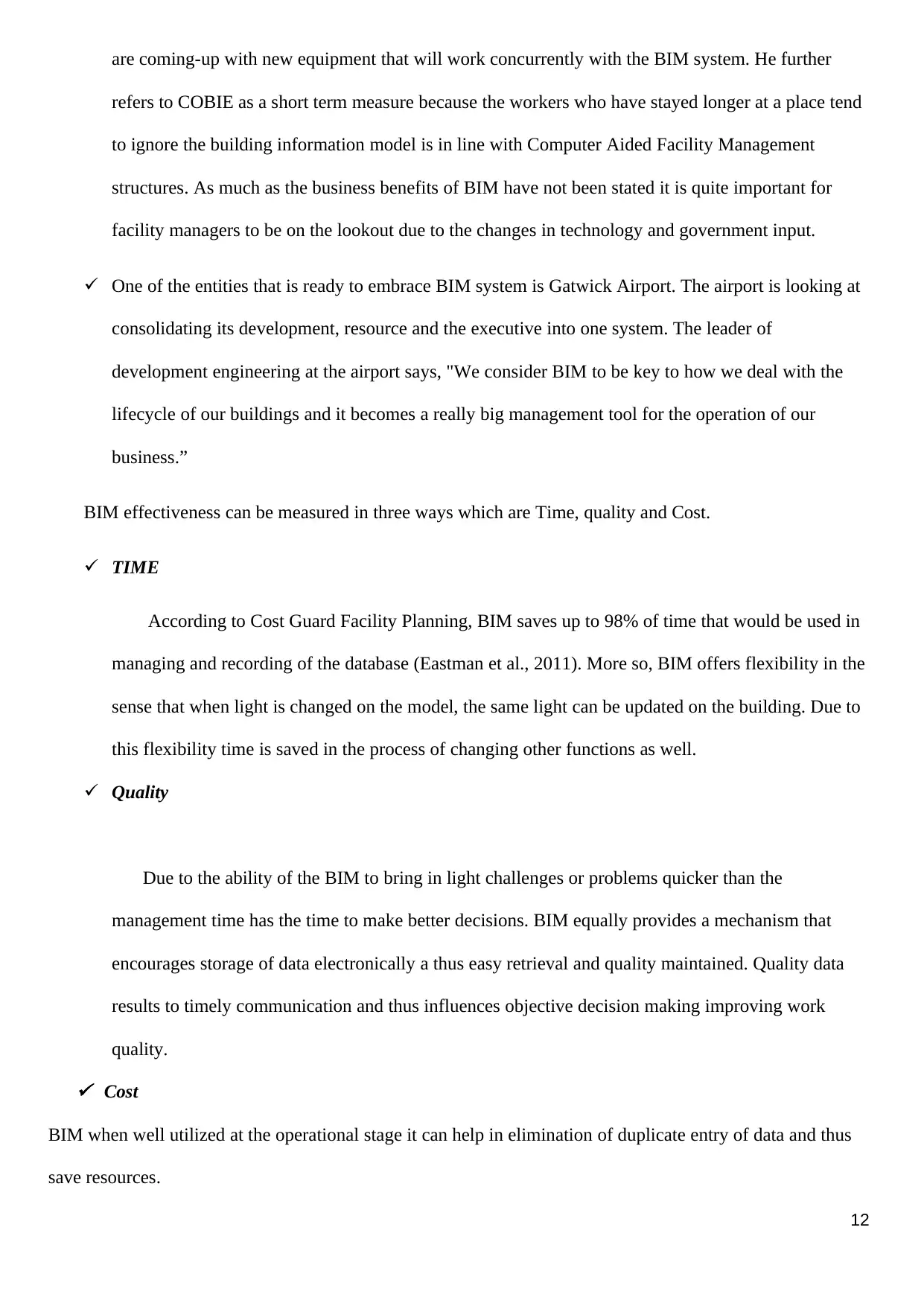
12
are coming-up with new equipment that will work concurrently with the BIM system. He further
refers to COBIE as a short term measure because the workers who have stayed longer at a place tend
to ignore the building information model is in line with Computer Aided Facility Management
structures. As much as the business benefits of BIM have not been stated it is quite important for
facility managers to be on the lookout due to the changes in technology and government input.
One of the entities that is ready to embrace BIM system is Gatwick Airport. The airport is looking at
consolidating its development, resource and the executive into one system. The leader of
development engineering at the airport says, "We consider BIM to be key to how we deal with the
lifecycle of our buildings and it becomes a really big management tool for the operation of our
business.”
BIM effectiveness can be measured in three ways which are Time, quality and Cost.
TIME
According to Cost Guard Facility Planning, BIM saves up to 98% of time that would be used in
managing and recording of the database (Eastman et al., 2011). More so, BIM offers flexibility in the
sense that when light is changed on the model, the same light can be updated on the building. Due to
this flexibility time is saved in the process of changing other functions as well.
Quality
Due to the ability of the BIM to bring in light challenges or problems quicker than the
management time has the time to make better decisions. BIM equally provides a mechanism that
encourages storage of data electronically a thus easy retrieval and quality maintained. Quality data
results to timely communication and thus influences objective decision making improving work
quality.
Cost
BIM when well utilized at the operational stage it can help in elimination of duplicate entry of data and thus
save resources.
are coming-up with new equipment that will work concurrently with the BIM system. He further
refers to COBIE as a short term measure because the workers who have stayed longer at a place tend
to ignore the building information model is in line with Computer Aided Facility Management
structures. As much as the business benefits of BIM have not been stated it is quite important for
facility managers to be on the lookout due to the changes in technology and government input.
One of the entities that is ready to embrace BIM system is Gatwick Airport. The airport is looking at
consolidating its development, resource and the executive into one system. The leader of
development engineering at the airport says, "We consider BIM to be key to how we deal with the
lifecycle of our buildings and it becomes a really big management tool for the operation of our
business.”
BIM effectiveness can be measured in three ways which are Time, quality and Cost.
TIME
According to Cost Guard Facility Planning, BIM saves up to 98% of time that would be used in
managing and recording of the database (Eastman et al., 2011). More so, BIM offers flexibility in the
sense that when light is changed on the model, the same light can be updated on the building. Due to
this flexibility time is saved in the process of changing other functions as well.
Quality
Due to the ability of the BIM to bring in light challenges or problems quicker than the
management time has the time to make better decisions. BIM equally provides a mechanism that
encourages storage of data electronically a thus easy retrieval and quality maintained. Quality data
results to timely communication and thus influences objective decision making improving work
quality.
Cost
BIM when well utilized at the operational stage it can help in elimination of duplicate entry of data and thus
save resources.

13
By the help of a BIM system facility managers are in a position to collect data on the assets
present in the building and also determine if they are maintainable. The whole process saves
the company contracting cost from 3% to 6% because it is in apposition to recognize and
track equipment’s in a building.
By the help of a BIM system facility managers are in a position to collect data on the assets
present in the building and also determine if they are maintainable. The whole process saves
the company contracting cost from 3% to 6% because it is in apposition to recognize and
track equipment’s in a building.
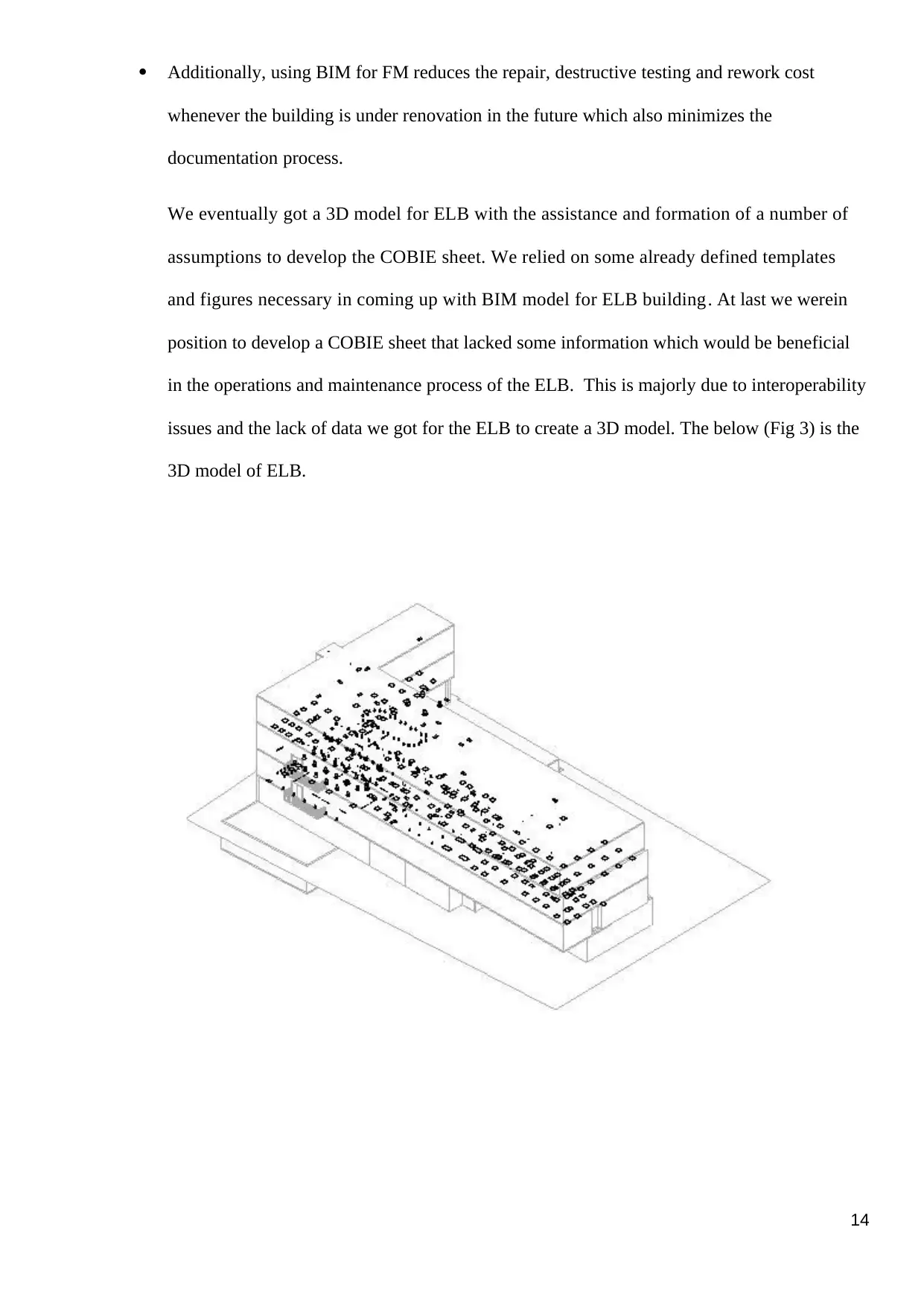
14
Additionally, using BIM for FM reduces the repair, destructive testing and rework cost
whenever the building is under renovation in the future which also minimizes the
documentation process.
We eventually got a 3D model for ELB with the assistance and formation of a number of
assumptions to develop the COBIE sheet. We relied on some already defined templates
and figures necessary in coming up with BIM model for ELB building. At last we werein
position to develop a COBIE sheet that lacked some information which would be beneficial
in the operations and maintenance process of the ELB. This is majorly due to interoperability
issues and the lack of data we got for the ELB to create a 3D model. The below (Fig 3) is the
3D model of ELB.
Additionally, using BIM for FM reduces the repair, destructive testing and rework cost
whenever the building is under renovation in the future which also minimizes the
documentation process.
We eventually got a 3D model for ELB with the assistance and formation of a number of
assumptions to develop the COBIE sheet. We relied on some already defined templates
and figures necessary in coming up with BIM model for ELB building. At last we werein
position to develop a COBIE sheet that lacked some information which would be beneficial
in the operations and maintenance process of the ELB. This is majorly due to interoperability
issues and the lack of data we got for the ELB to create a 3D model. The below (Fig 3) is the
3D model of ELB.
Secure Best Marks with AI Grader
Need help grading? Try our AI Grader for instant feedback on your assignments.
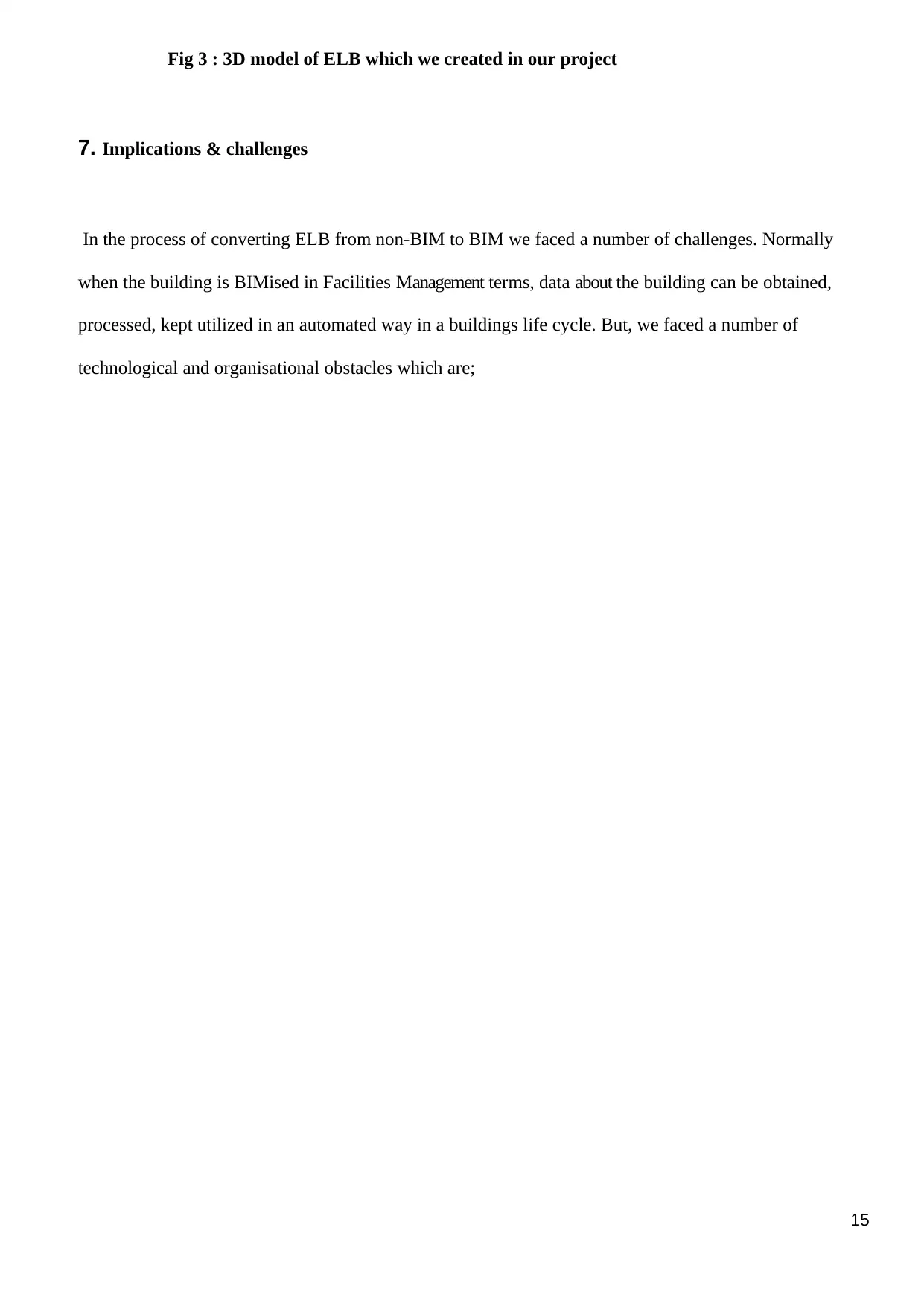
15
Fig 3 : 3D model of ELB which we created in our project
7. Implications & challenges
In the process of converting ELB from non-BIM to BIM we faced a number of challenges. Normally
when the building is BIMised in Facilities Management terms, data about the building can be obtained,
processed, kept utilized in an automated way in a buildings life cycle. But, we faced a number of
technological and organisational obstacles which are;
Fig 3 : 3D model of ELB which we created in our project
7. Implications & challenges
In the process of converting ELB from non-BIM to BIM we faced a number of challenges. Normally
when the building is BIMised in Facilities Management terms, data about the building can be obtained,
processed, kept utilized in an automated way in a buildings life cycle. But, we faced a number of
technological and organisational obstacles which are;
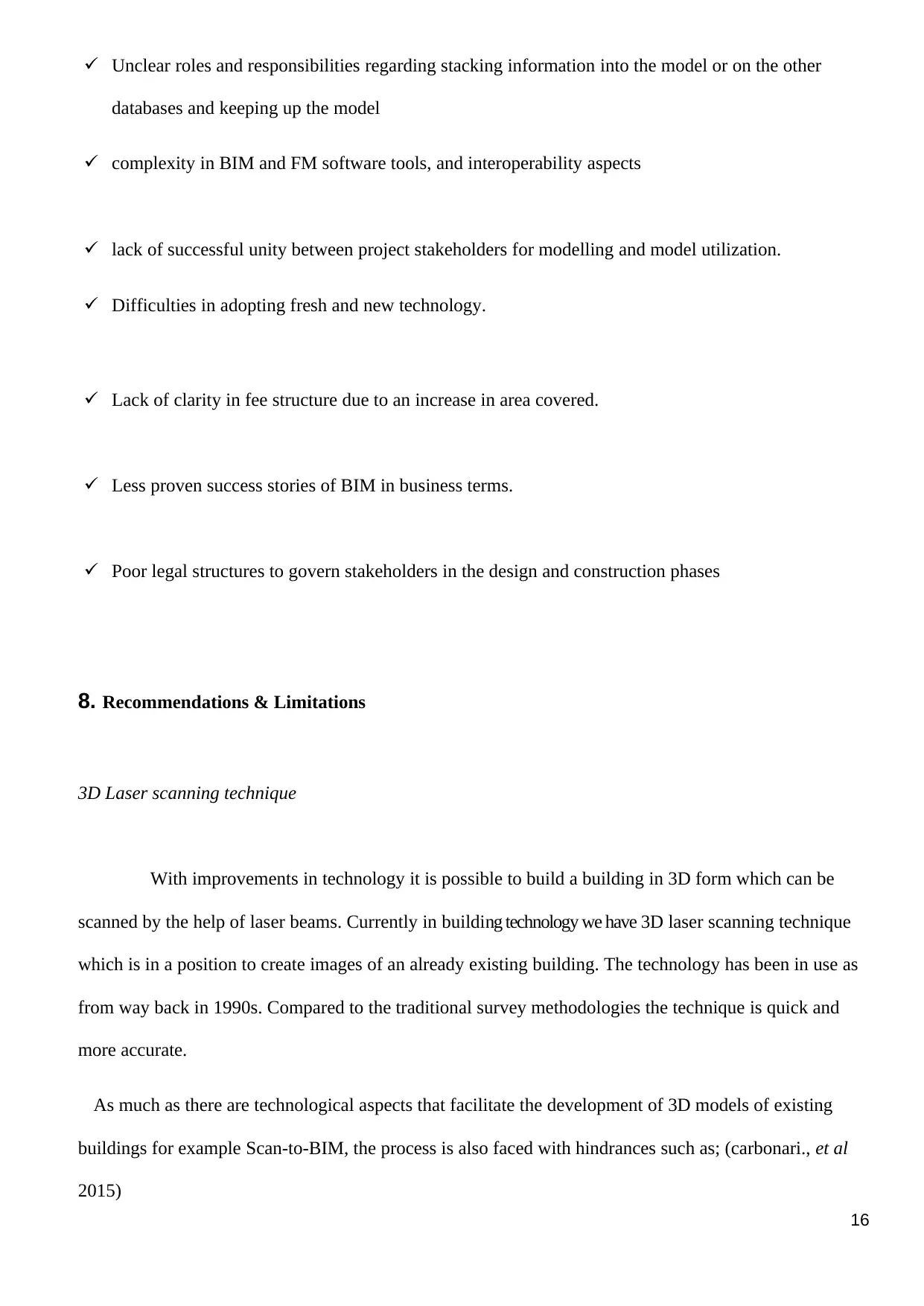
16
Unclear roles and responsibilities regarding stacking information into the model or on the other
databases and keeping up the model
complexity in BIM and FM software tools, and interoperability aspects
lack of successful unity between project stakeholders for modelling and model utilization.
Difficulties in adopting fresh and new technology.
Lack of clarity in fee structure due to an increase in area covered.
Less proven success stories of BIM in business terms.
Poor legal structures to govern stakeholders in the design and construction phases
8. Recommendations & Limitations
3D Laser scanning technique
With improvements in technology it is possible to build a building in 3D form which can be
scanned by the help of laser beams. Currently in building technology we have 3D laser scanning technique
which is in a position to create images of an already existing building. The technology has been in use as
from way back in 1990s. Compared to the traditional survey methodologies the technique is quick and
more accurate.
As much as there are technological aspects that facilitate the development of 3D models of existing
buildings for example Scan-to-BIM, the process is also faced with hindrances such as; (carbonari., et al
2015)
Unclear roles and responsibilities regarding stacking information into the model or on the other
databases and keeping up the model
complexity in BIM and FM software tools, and interoperability aspects
lack of successful unity between project stakeholders for modelling and model utilization.
Difficulties in adopting fresh and new technology.
Lack of clarity in fee structure due to an increase in area covered.
Less proven success stories of BIM in business terms.
Poor legal structures to govern stakeholders in the design and construction phases
8. Recommendations & Limitations
3D Laser scanning technique
With improvements in technology it is possible to build a building in 3D form which can be
scanned by the help of laser beams. Currently in building technology we have 3D laser scanning technique
which is in a position to create images of an already existing building. The technology has been in use as
from way back in 1990s. Compared to the traditional survey methodologies the technique is quick and
more accurate.
As much as there are technological aspects that facilitate the development of 3D models of existing
buildings for example Scan-to-BIM, the process is also faced with hindrances such as; (carbonari., et al
2015)

17
Scans obtained from the indoors are not accurate and thus not in sync with the outdoor shapes
and additionally complicated designs are hard to generate.
Furthermore, the large quantity of data extracted in the scanning process in most cases slows
reduces the pace of the creation process.
Lastly, the devices needed for the scanning process are expensive.
Scans obtained from the indoors are not accurate and thus not in sync with the outdoor shapes
and additionally complicated designs are hard to generate.
Furthermore, the large quantity of data extracted in the scanning process in most cases slows
reduces the pace of the creation process.
Lastly, the devices needed for the scanning process are expensive.
Paraphrase This Document
Need a fresh take? Get an instant paraphrase of this document with our AI Paraphraser

18
Due to the complex nature of the whole process, it makes it difficult for organizations to invest in. Some of
the huddles include the effort, level of education and the costs involved. In our opinion, we recommend
extensive research and study in the days to come on how to develop building information models for already
present buildings in order to reduce the existing technological difference.
Conclusion
Conclusively, we managed to come-up with a detailed plan of how BIM technology could be put
to use in the process of property management. In the report we delved into the problems that were facing
the University and in turn developed a roadmap that could be utilized by other facility management
teams in unifying of operations and maintenance. In our report we provide the solution of converting the
non-BIM buildings to BIM and also changing from the 2D to 3D model spreadsheet for Facilities
management systems. We equally depict how best to make the changes in cost friendly way by
conducting a detailed feasibility study.
To begin with, the credibility of the report is based on the methodology employed in the process
of converting the FM system from 2D to 3D. We utilized an already established system in CIS Building
to develop a 3D model for Ellison B block which was non-BIM. The move offers the Facilities
Management team a solution which unifies all the operations and maintenance process. Additionally, the
report gets into details about the challenges that came up when conducting the task and further gives
recommendations to overcome the same. Therefore, the study provides a platform on which future
research and study can be done in regards to the difference that exists in between CAFM and BIM in
regards to the process of operating and maintaining of buildings in the University. If the system
suggested by the report works well in ELB then it could be implemented in all the buildings and thus
create a unified Facilities Management system.
Lastly, here are some of the aspects I came to learn about myself while tackling the task we were given;
I understood that we had enough discipline since we were in a position to acquire knowledge
working at the university which is a real working station.
Due to the complex nature of the whole process, it makes it difficult for organizations to invest in. Some of
the huddles include the effort, level of education and the costs involved. In our opinion, we recommend
extensive research and study in the days to come on how to develop building information models for already
present buildings in order to reduce the existing technological difference.
Conclusion
Conclusively, we managed to come-up with a detailed plan of how BIM technology could be put
to use in the process of property management. In the report we delved into the problems that were facing
the University and in turn developed a roadmap that could be utilized by other facility management
teams in unifying of operations and maintenance. In our report we provide the solution of converting the
non-BIM buildings to BIM and also changing from the 2D to 3D model spreadsheet for Facilities
management systems. We equally depict how best to make the changes in cost friendly way by
conducting a detailed feasibility study.
To begin with, the credibility of the report is based on the methodology employed in the process
of converting the FM system from 2D to 3D. We utilized an already established system in CIS Building
to develop a 3D model for Ellison B block which was non-BIM. The move offers the Facilities
Management team a solution which unifies all the operations and maintenance process. Additionally, the
report gets into details about the challenges that came up when conducting the task and further gives
recommendations to overcome the same. Therefore, the study provides a platform on which future
research and study can be done in regards to the difference that exists in between CAFM and BIM in
regards to the process of operating and maintaining of buildings in the University. If the system
suggested by the report works well in ELB then it could be implemented in all the buildings and thus
create a unified Facilities Management system.
Lastly, here are some of the aspects I came to learn about myself while tackling the task we were given;
I understood that we had enough discipline since we were in a position to acquire knowledge
working at the university which is a real working station.

19
I equally came to know that I could work with no supervision as I was in apposition to achieve my
personal tasks and also collective group responsibilities.
Depicted understanding of class works through application of the knowledge obtain during the
project
I was also able to pass information and explain concepts clearly both verbally and in writing.
I equally came to know that I could work with no supervision as I was in apposition to achieve my
personal tasks and also collective group responsibilities.
Depicted understanding of class works through application of the knowledge obtain during the
project
I was also able to pass information and explain concepts clearly both verbally and in writing.
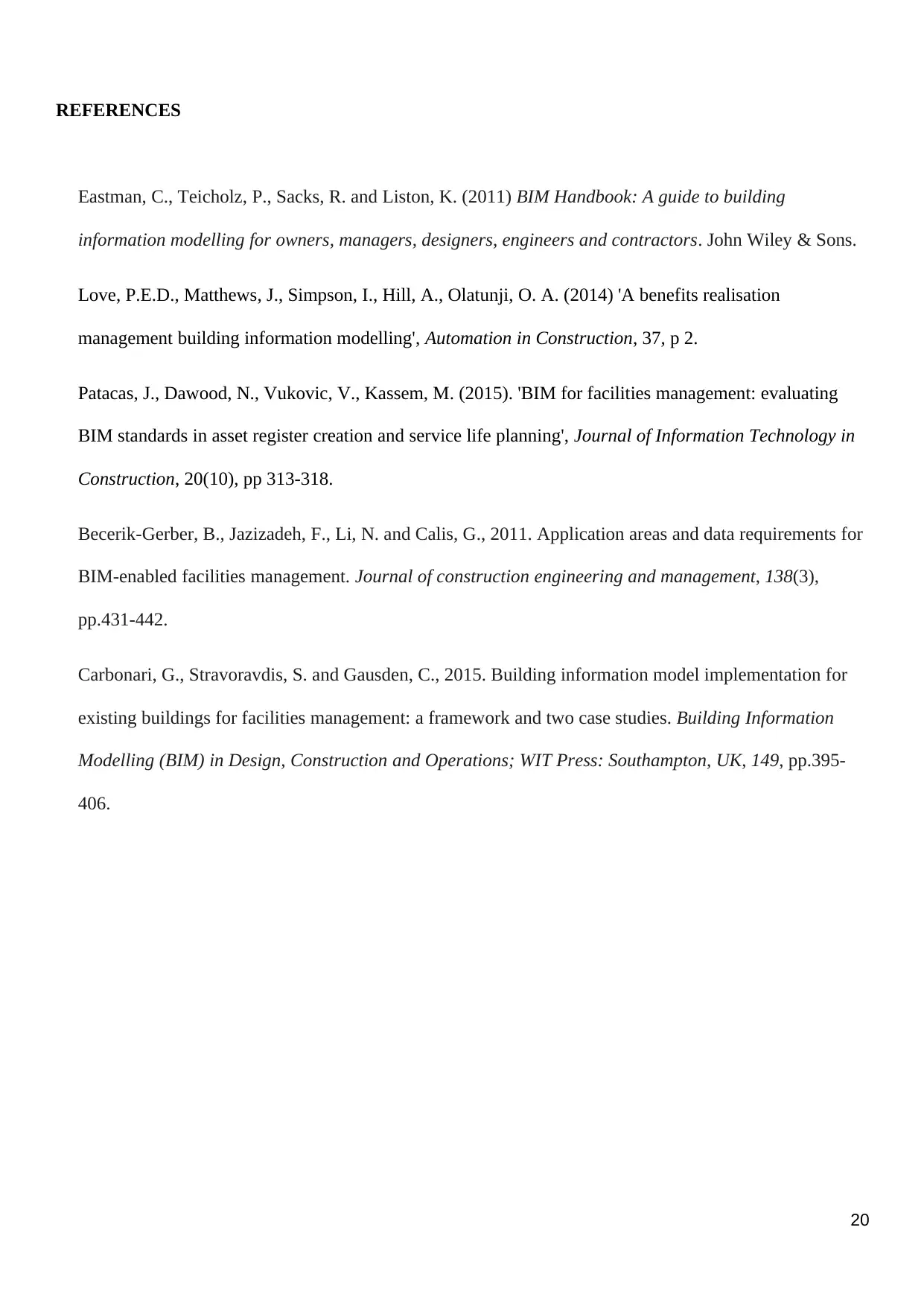
20
REFERENCES
Eastman, C., Teicholz, P., Sacks, R. and Liston, K. (2011) BIM Handbook: A guide to building
information modelling for owners, managers, designers, engineers and contractors. John Wiley & Sons.
Love, P.E.D., Matthews, J., Simpson, I., Hill, A., Olatunji, O. A. (2014) 'A benefits realisation
management building information modelling', Automation in Construction, 37, p 2.
Patacas, J., Dawood, N., Vukovic, V., Kassem, M. (2015). 'BIM for facilities management: evaluating
BIM standards in asset register creation and service life planning', Journal of Information Technology in
Construction, 20(10), pp 313-318.
Becerik-Gerber, B., Jazizadeh, F., Li, N. and Calis, G., 2011. Application areas and data requirements for
BIM-enabled facilities management. Journal of construction engineering and management, 138(3),
pp.431-442.
Carbonari, G., Stravoravdis, S. and Gausden, C., 2015. Building information model implementation for
existing buildings for facilities management: a framework and two case studies. Building Information
Modelling (BIM) in Design, Construction and Operations; WIT Press: Southampton, UK, 149, pp.395-
406.
REFERENCES
Eastman, C., Teicholz, P., Sacks, R. and Liston, K. (2011) BIM Handbook: A guide to building
information modelling for owners, managers, designers, engineers and contractors. John Wiley & Sons.
Love, P.E.D., Matthews, J., Simpson, I., Hill, A., Olatunji, O. A. (2014) 'A benefits realisation
management building information modelling', Automation in Construction, 37, p 2.
Patacas, J., Dawood, N., Vukovic, V., Kassem, M. (2015). 'BIM for facilities management: evaluating
BIM standards in asset register creation and service life planning', Journal of Information Technology in
Construction, 20(10), pp 313-318.
Becerik-Gerber, B., Jazizadeh, F., Li, N. and Calis, G., 2011. Application areas and data requirements for
BIM-enabled facilities management. Journal of construction engineering and management, 138(3),
pp.431-442.
Carbonari, G., Stravoravdis, S. and Gausden, C., 2015. Building information model implementation for
existing buildings for facilities management: a framework and two case studies. Building Information
Modelling (BIM) in Design, Construction and Operations; WIT Press: Southampton, UK, 149, pp.395-
406.
1 out of 22
Your All-in-One AI-Powered Toolkit for Academic Success.
+13062052269
info@desklib.com
Available 24*7 on WhatsApp / Email
![[object Object]](/_next/static/media/star-bottom.7253800d.svg)
Unlock your academic potential
© 2024 | Zucol Services PVT LTD | All rights reserved.